#subsurface oceans
Explore tagged Tumblr posts
Text
Io's Missing Magma Ocean

In the late 1970s, scientists conjectured that Io was likely a volcanic world, heated by tidal forces from Jupiter that squeeze it along its elliptical orbit. Only months later, images from Voyager 1's flyby confirmed the moon's volcanism. Magnetometer data from Galileo's later flyby suggested that tidal heating had created a shallow magma ocean that powered the moon's volcanic activity. But newly analyzed data from Juno's flyby shows that Io doesn't have a magma ocean after all. (Image credit: NASA/JPL/USGS; research credit: R. Park et al.; see also Quanta) Read the full article
#fluid dynamics#geophysics#Io#magma#physics#planetary science#science#subsurface oceans#tidal heating#volcano
57 notes
·
View notes
Text
When Cassini passed through an ice particle stream from one of the Enceladus geysers, it detected organic molecules as well as water. This makes the tiny moon a surprising candidate for detection of some kind of life, since three essential building blocks of life: heat, liquid water, and organic molecules, are all present. If there is life in the subsurface ocean, it would be a reasonable assumption that evidence of life could be collected on the surface, without deep drilling.
The European Space Agency is planning to LAND a space probe on Enceladus, to look for signs of life. Aerospatiale, as part of ESA, built the Huygens lander, which successfully reached the surface of Titan. But it had a free ride on Cassini. Sending a probe from Earth to Saturn, and then landing on a moon, even a small one, requires a challenging amount of delta-V. This probe would most likely be considerably smaller than the school bus sized Cassini. Perhaps the new Ariane 6 could handle the job? Or a Falcon Heavy?
#Enceladus#subsurface oceans#extraterrestial life#ESA#large delta-v#Ariane 6#Falcon Heavy#cassini huygens
0 notes
Photo
Europa gets more tidal heating, but Ganymede is larger, and would have a hotter core. Life on Earth could have gotten its start around our deep-sea hydrothermal vents, with their abundant supply of minerals, chemical energy, and a large temperature gradient.
Could one or both of these worlds also have hydrothermal vents?
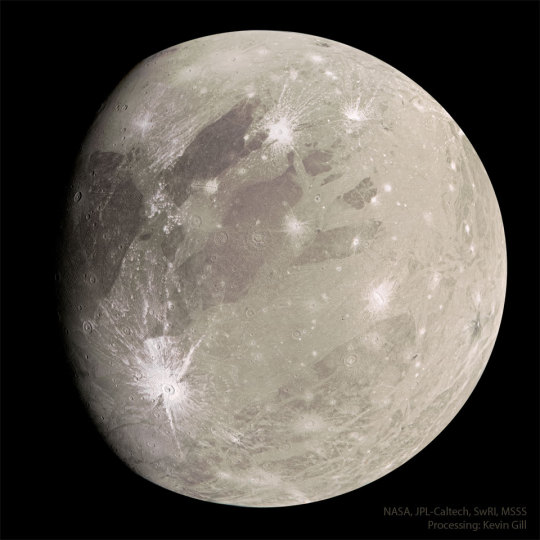
2023 November 28
Ganymede from Juno Image Credit & Copyright: NASA/JPL-Caltech/SwRI/MSSS; Processing & License: Kevin M. Gill;
Explanation: What does the largest moon in the Solar System look like? Jupiter’s moon Ganymede, larger than even Mercury and Pluto, has an icy surface speckled with bright young craters overlying a mixture of older, darker, more cratered terrain laced with grooves and ridges. The cause of the grooved terrain remains a topic of research, with a leading hypothesis relating it to shifting ice plates. Ganymede is thought to have an ocean layer that contains more water than Earth – and might contain life. Like Earth’s Moon, Ganymede keeps the same face towards its central planet, in this case Jupiter. The featured image was captured in 2021 by NASA’s robotic Juno spacecraft when it passed by the immense moon. The close pass reduced Juno’s orbital period around Jupiter from 53 days to 43 days. Juno continues to study the giant planet’s high gravity, unusual magnetic field, and complex cloud structures.
∞ Source: apod.nasa.gov/apod/ap231128.html
109 notes
·
View notes
Link
Space Nuts Episode 499: Asteroid Updates, Life in the Cosmos, and SpaceX Mishaps Join Andrew Dunkley and Professor Jonti Horner in this exciting episode of Space Nuts, where they delve into the latest developments in asteroid research, the ongoing quest for extraterrestrial life, and some recent SpaceX controversies. From the fate of asteroid 2024 YR4 to the intriguing possibilities of subsurface oceans on icy moons, this episode is packed with information that will keep you on the edge of your seat. Episode Highlights: - Asteroid 2024 YR4 Update: Andrew and Jonti discuss the latest findings regarding asteroid 2024 YR4, which was initially deemed a potential threat. They clarify the current low probability of impact and explore the implications for both Earth and the Moon, including what would happen if it were to collide with the lunar surface. - Are We Alone in the Universe? The duo tackles the age-old question of extraterrestrial life, discussing new data and the challenges scientists face in searching for evidence of life beyond Earth. They consider the likelihood of finding simple versus complex life forms in the cosmos and the significance of ongoing missions aimed at detecting signs of life within our solar system. - SpaceX's Recent Challenges: The conversation shifts to SpaceX, where Andrew and Jonti analyze the recent mishaps involving their rockets, including uncontrolled reentries and debris falling over populated areas. They discuss the implications of these events for space safety and the future of space exploration. - Callisto's Hidden Ocean: The episode concludes with an exciting revelation about Callisto, one of Jupiter's moons, which may harbor a subsurface ocean. Jonti explains how new analysis techniques have strengthened the case for liquid water beneath its icy surface, further expanding the possibilities for life in our solar system. For more Space Nuts, including our continually updating newsfeed and to listen to all our episodes, visit our website. Follow us on social media at SpaceNutsPod on Facebook, X, YouTube Music Music, Tumblr, Instagram, and TikTok. We love engaging with our community, so be sure to drop us a message or comment on your favorite platform. If you'd like to help support Space Nuts and join our growing family of insiders for commercial-free episodes and more, visit spacenutspodcast.com/about Stay curious, keep looking up, and join us next time for more stellar insights and cosmic wonders. Until then, clear skies and happy stargazing. 00:00 - Introduction and asteroid update 02:15 - Current status of asteroid 2024 YR4 10:30 - Discussion on extraterrestrial life 18:00 - SpaceX mishaps and debris concerns 26:45 - Callisto's potential subsurface ocean 30:00 - Closing thoughts and listener engagement ✍️ Episode References Asteroid Impact Probability Analysis https://www.nasa.gov/asteroid-impact SETI Research and Extraterrestrial Life https://www.seti.org/ Callisto's Subsurface Ocean Study https://www.universetoday.com/callisto-ocean
#2024#asteroid#callisto#europa#extraterrestrial#ganymede#impact#life#liquid#lunar#news#ocean#research#seti#spacenuts#spacex#subsurface#update#water#yr4
0 notes
Text

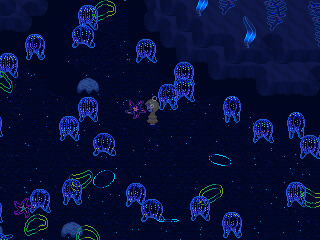
Ocean Subsurface, I love the starfish here
1 note
·
View note
Text
Interesting! Proxima Centauri, like many red dwarf stars, is probably a flare star. This would likely make the surface of Proxima b uninhabitable, and might even destroy any atmosphere it originally had. However, if there were a subsurface ocean, it would be protected from Proxima’s radiation, and could possibly be habitable.

Habitability of nearby Earth-sized Exoplanets
When it comes to planets, our Solar system is not alone, and more recently our ability to confirm and spot smaller rocky planets has been adding to our understanding of how planets are formed and that our Solar System far from being a model to use elsewhere, is rather unique.

Still, moons like Europa may offer a model by which we can judge water on those Earth sized planets that happen to be within the habitable zone (or slightly either side of it) and how interactions with their stars and environment could look.
Proxima b is one particular exo-planet of interest, orbiting it's host star Proxima Centauri every 11 days, but with Proxima being a very small red dwarf, that put's the planet within the area we'd expect to see liquid water.

A recent study of a number of similar exoplanets including Proxima b, and comparing them to Europa, has shown that the planets are likely much colder than first assumed, but also covered in ice with subsurface oceans. Proxima b in particular is calculated to have the thinnest ice sheet with an average of just 58m, and with the tidal forces from Proxima heating up the interior, it's expected the planet will have thousands of time more water upwelling and guizers constantly delivering liquid water to the surface.
While this is all theoretical, we are now able to test the hypothesis, as Proxima b passes it's star so frequently, sufficient observations of the planet's transit could yield water vapour at varying levels. Expect JWST to be watching in the near future !
Source :
44 notes
·
View notes
Text
far too many planets with proposed subsurface oceans. get some water on top of that shit and then we'll talk.
1K notes
·
View notes
Text
More pocked with craters than any other object in our solar system, Jupiter's outermost and second-biggest Galilean moon, Callisto, appears geologically unremarkable. In the 1990s, however, NASA's Galileo spacecraft captured magnetic measurements near Callisto that suggested that its ice shell surface—much like that of Europa, another moon of Jupiter—may encase a salty, liquid water ocean. But evidence for Callisto's subsurface ocean has remained inconclusive, as the moon has an intense ionosphere. Scientists thought this electrically conductive upper part of the moon's atmosphere might imitate the magnetic fingerprint of a salty, conductive ocean. Now, researchers have revisited the Galileo data in more detail. Unlike in prior studies, this team incorporated all available magnetic measurements from Galileo's eight close flybys of Callisto. Their expanded analysis much more strongly suggests that Callisto hosts a subsurface ocean. The paper is published in the journal AGU Advances.
Continue Reading.
180 notes
·
View notes
Text
Methane on the surface of Eris and Makemake do not have the correct isotopic ratio to be formed primordially. The conclusion is that the methane was formed by geochemistry which requires a hot core, which might also make subsurface oceans possible.
0 notes
Text
Paradigm shift: Titan and Ganymede are two of many moons that appear to have subsurface oceans.
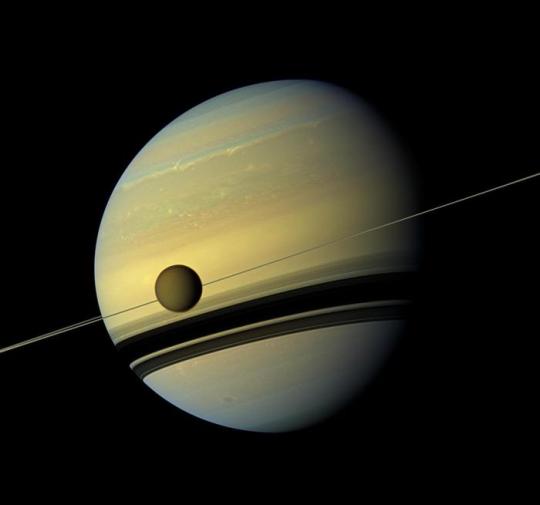
Studies of geologic faulting on icy moons aid exploration of extraterrestrial watery worlds
On the surface of many of the icy moons in our solar system, scientists have documented strike-slip faults, those that occur when fault walls move past one another sideways, as is the case at the San Andreas fault in California. Two recently published studies led by University of Hawai‘i at Mānoa earth and space scientists document and reveal the mechanisms behind these geologic features on the largest moon of Saturn, Titan, and Jupiter’s largest moon, Ganymede.
“We are interested in studying shear deformation on icy moons because that type of faulting can facilitate the exchange of surface and subsurface materials through shear heating processes, potentially creating environments conducive for the emergence of life,” said Liliane Burkhard, lead author of the studies and research affiliate at the Hawai‘i Institute of Geophysics and Planetology in the UH Mānoa School of Ocean and Earth Science and Technology.
When an icy moon moves around its parent planet, the gravity of the planet can cause tidal flexing of the surface of the moon, which can drive geologic activity such as strike-slip faulting. Tidal stresses vary as the moon changes distance from its planet because the moon’s orbit can be elliptical rather than circular.
Titan, a frozen ocean world
The extremely cold temperatures on the surface of Titan mean that water ice acts as rock that can crack, fault, and deform. Evidence from the Cassini spacecraft suggests that tens of miles below the frozen surface, there is a liquid water ocean. Further, Titan is the only moon in our solar system with a dense atmosphere, which, uniquely, supports an Earth-like hydrological cycle of methane clouds, rain, and liquid flowing across the surface to fill lakes and seas, placing it among a handful of worlds that could potentially contain habitable environments.
The NASA Dragonfly mission will launch in 2027, with a planned arrival on Titan in 2034. The novel rotorcraft lander will conduct several flights on the surface, exploring a variety of locations to search for the building blocks and signs of life.
In their investigation of the Selk crater area on Titan, the designated initial landing site for the Dragonfly mission, Burkhard and her co-author explored the potential for shear deformations and strike-slip faulting. To do this, they calculated the stress that would be exerted on Titan’s surface due to tidal forces as the moon orbits Saturn and tested the possibility of faulting by examining various characteristics of the frozen ground.
“While our prior research indicated that certain areas on Titan might currently undergo deformation due to tidal stresses, the Selk crater area would need to host very high pore fluid pressures and a low crustal coefficient of friction for shear failure, which seems improbable,” said Burkhard. “Consequently, it's safe to infer that Dragonfly won't be landing in a strike-slip ditch!”
Ganymede, a moon with a checkered past
In a second publication, Burkhard and her co-authors investigated the geologic history of Ganymede, Jupiter’s largest moon, in the area of Nippur/Philus Sulci by examining high-resolution data available for this region and conducting a tidal stress investigation of Ganymede’s past.
Ganymede has documented strike-slip faults on the surface, but its current orbit is too circular, as opposed to elliptical, to cause any tidal stress deformation.
The researchers found that several crosscutting bands of light terrain in the Nippur/Philus Sulci site show varying degrees of tectonic deformation, and the chronology of tectonic activity implied by mapped crosscutting relationships revealed three eras of distinct geologic activity: ancient, intermediate and youngest.
“I investigated strike-slip faulting features in intermediate-aged terrain, and they correspond in slip direction to the predictions from modeling stresses of a higher past eccentricity. Ganymede could have undergone a period where its orbit was much more elliptical than it is today,” said Burkhard.
Other shear features found in younger geologic units in the same region do not align in slip direction with typical first-order shear indicators.
“This suggests that these features might have formed through another process and not necessarily due to higher tidal stresses,” Burkhard added. “So, Ganymede has had a tidal ‘mid-life crisis’, but its youngest ‘crisis’ remains enigmatic.”
The recent studies along with space exploration missions create a positive feedback of knowledge.
“Geologic investigations, such as these, prior to launch and arrival, inform and guide mission activities,” said Burkhard. “And missions such as Dragonfly, Europa Clipper and ESA’s JUICE will further constrain our modeling approach and can help pinpoint the most interesting locations for lander exploration and possibly for gaining access to the interior ocean of icy moons.”
IMAGE....Titan orbits Saturn. Below Titan are the shadows cast by Saturn’s rings. CREDIT NASA/JPL-Caltech/Space Science Institute
7 notes
·
View notes
Text
Boys go to Jupiter to study the subsurface ice oceans of Europa and build a semi-permanent installation on Callisto to better studying the entire Jovian system
235 notes
·
View notes
Note
There is a trope in older sci-fi that Mars was once green planet like Earth, but then something happened and it turned into a dessert where water is scarce, but biosphere ultimately survived.
Like, is there any way something like this can happen realistically on any planet? Maybe not water disappearing of the planet but largely going deep underground so it's not accessible to surface inhabitants?
Well, it IS what literally happened to Mars. Actually, what happened, or what it's believed happened, is that Mars didn't have enough of a magnetic field to prevent the solar wind from stripping away its atmosphere, and it didn't have a large mass like the Earth to keep it in any case. Incidentally, this is why the Moon is also lifeless despite being in the "habitable zone" where it could have liquid water: it simply doesn't have a magnetic field or is massive enough (despite being so big it could count as the Solar System's 5th inner "planet"). Another thing against Mars is its apparent lack of plate tectonics, which, at least on Earth-like worlds, require oceans as a "lubricant", so to speak. Without plate tectonics and only with ocassional volcanoes, the Martian atmosphere and its CO2 could not regenerate (and this is vital for keeping greenhouse gases, especially for a world far away from the Sun like Mars), so it's the way it is today.
However, this was apparently a slow process. Oceans on Mars apparently existed as far as 2 billion years ago, at the same time Earth also had life. It's possible that the own circulation of the water in the ocean managed it to keep from freezing, even if the atmosphere was cold. This is all very on the air right now but if this is true, it means that the Solar System had 2 worlds with liquid water oceans. Maybe 3, the situation at Venus is not well known.
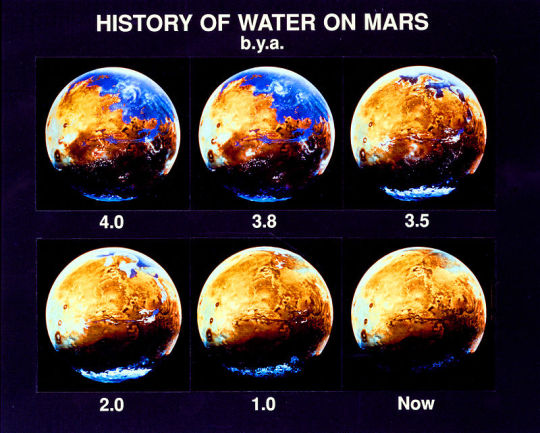
And indeed, like you said, water doesn't just "dissapear", it has to go somewhere. In the case of Mars, it froze underground and on the ice caps, or otherwise was blown away as water vapor as the atmosphere depleted (with not atmospheric pressure, it can't remain as liquid). This is still hugely debated though. Every time something like water flows or subsurface lakes is discovered there's endless debate on what's going on Mars, but I think it's fair to say there must be lots of frozen water there.
In worldbuilding, you could indeed have a desert world this way. It could be that intelligent life evolved at the last days of it as an oceanic world, with the water cycle mostly locked in glaciers and sub-surface ice, and besides the equator everything else is cold, barren desert. In fact, Mars is basically this. If it had a breathable atmosphere it would resemble such a setting.
However, one has to wonder how would life would survive in such a setting, if there's no oceans with phytoplankton or forests and vegetation to replenish oxygen. Vegetation is very hardy, many deserts that aren't dunes or rock have some. But there are limits.
Arrakis from Dune had this same logical problem and Frank Herbert knew it. He solved it by making the sandworms (MAY HIS PASSAGE CLEANSE THE WORLD. MAY HE KEEP THE WORLD FOR HIS PEOPLE) produce oxygen. This makes a lot of sense. After all, Dune is covered in dunes, and sand is made mostly of silicon dioxide. So if the digestive processes of the sandworm digest silicon dioxide, this would give a lot of oxygen. How many sandworms and at what rate would they produce oxygen is debatable, but there is a working mechanism. Some funky stuff like that might work in places like Tatooine too. But I believe even some small oceans or places with vegetation would be able to sustain an oxygen atmosphere, especially if the atmosphere was oxygenated already. It's a careful balance though.
Another way to get desert worlds is to look at the future of our own Earth. Even before the Sun becomes a red giant, the Sun will increase in brightness and the temperature will rise. One billion years from now, most carbon dioxide on the atmosphere will be sequestered by erosion and geological processes, and if not replenished by volcanoes and tectonics (which are predicted to slow down too, especially with the oceans deplenishing), there would be little photosythesis with only hardy plants surviving, most life will only survive in the poles or at high altitudes, it's likely that water life will also start going extinct without dissolved oxygen. The oceans will also eventually start to evaporate and there are two options here: Earth might become a hellish greenhouse world like Venus, if they evaporate slowly and it remains in the atmosphere, or the evaporation might be rapid, which might make, as I understand it, a brief wet period, and then desert as it desintegrates in the upper atmosphere. It all depends on how long tectonics go on (as continents grow, deserts will too) and if there are other events, though. This is still hugely debated, currently I'm reading The Life And Death of Planet Earth which talks about such happy topics as these.
There's also another posibility, that your planet just wasn't formed with enough water and atmosphere in the first place. It's some point of debate on how much water and atmospheric pressure an Earth-like planet needs to sustain life. But you could concievable have a much lesser atmosphere and surface water than Earth, and this atmosphere would remain 'sunk' in lowlands, valleys, craters, etc. separated by lifeless highlands (or highlands with very sparse extremophile life). This might make some really strange stuff, but it would be great for a speculative biology project.
(if you liked this post and would like to read more worldbuilding stuff, consider tipping me here!)
321 notes
·
View notes
Text
The Best News of Last Week - August 21, 2023
🌊 - Discover the Ocean's Hidden Gem Deep down in the Pacific
1. Massachusetts passed a millionaire's tax. Now, the revenue is paying for free public school lunches.

Every kid in Massachusetts will get a free lunch, paid for by proceeds from a new state tax on millionaires.
A new 4% tax on the state's wealthiest residents will account for $1 billion of the state's $56 billion fiscal budget for 2024, according to state documents. A portion of those funds will be used to provide all public-school students with free weekday meals, according to State House News Service.
2. Plant-based filter removes up to 99.9% of microplastics from water

Researchers may have found an effective, green way to remove microplastics from our water using readily available plant materials. Their device was found to capture up to 99.9% of a wide variety of microplastics known to pose a health risk to humans.
3. Scientists Find A Whole New Ecosystem Hiding Beneath Earth's Seafloor
youtube
Most recently, aquanauts on board a vessel from the Schmidt Ocean Institute used an underwater robot to turn over slabs of volcanic crust in the deep, dark Pacific. Underneath the seafloor of this well-studied site, the international team of researchers found veins of subsurface fluids swimming with life that has never been seen before.
It's a whole new world we didn't know existed.
4. How solar has exploded in the US in just a year
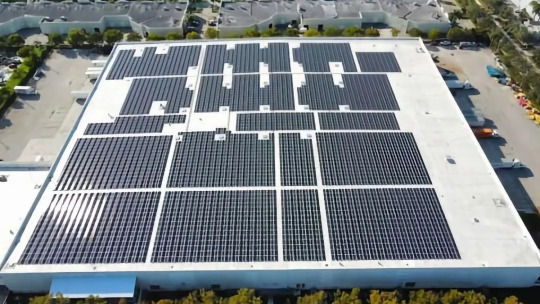
Solar and storage companies have announced over $100 billion in private sector investments in the US since the passage of the Inflation Reduction Act (IRA) a year ago, according to a new analysis released today by the Solar Energy Industries Association (SEIA).
Since President Joe Biden signed the IRA in August 2022, 51 solar factories have been announced or expanded in the US.
5. Researchers have identified a new pack of endangered gray wolves in California

A new pack of gray wolves has shown up in California’s Sierra Nevada, several hundred miles away from any other known population of the endangered species, wildlife officials announced Friday.
It’s a discovery to make researchers howl with delight, given that the native species was hunted to extinction in California in the 1920s. Only in the past decade or so have a few gray wolves wandered back into the state from out-of-state packs.
6. Record-Breaking Cleanup: 25,000 Pounds of Trash Removed from Pacific Garbage Patch
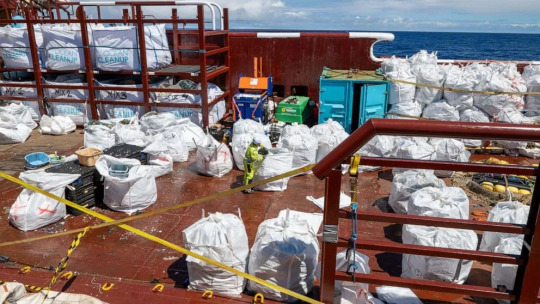
Ocean cleanup crews have fished out the most trash ever taken from one of the largest garbage patches in the world.
The Ocean Cleanup, a nonprofit environmental engineering organization, saw its largest extraction earlier this month by removing about 25,000 pounds of trash from the Great Pacific Garbage Patch, Alex Tobin, head of public relations and media for the organization
7. The Inflation Reduction Act Took U.S. Climate Action Global

The U.S. Inflation Reduction Act (IRA) aimed to promote clean energy investments in the U.S. and globally. In its first year, the IRA successfully spurred other nations to develop competitive climate plans.
Clean energy projects in 44 U.S. states driven by the IRA have generated over 170,600 jobs and $278 billion in investments, aligning with Paris Agreement goals.
---
That's it for this week :)
This newsletter will always be free. If you liked this post you can support me with a small kofi donation here:
Buy me a coffee ❤️
Also don’t forget to reblog this post with your friends.
1K notes
·
View notes
Link
SpaceTime Series 28 Episode 20 The Astronomy, Space and Science News Podcast New Discoveries on Earth's Elements, Uranus's Moon Ariel, and the Fate of Comet Atlas In this episode of SpaceTime, we delve into a groundbreaking study that challenges long-held beliefs about the origins of Earth's missing moderately volatile elements, such as copper and zinc. This research suggests that rather than being lost during the early formation of the solar system, these essential elements were likely retained by the first planetesimals and lost later due to violent cosmic collisions during planetary growth, reshaping our understanding of planetary chemistry and habitability. Uranus's Moon Ariel: A Window to Its Interior We also explore the fascinating trench-like features on Uranus's moon Ariel, which may serve as conduits for internal materials. New research indicates that these medial grooves could provide insights into Ariel's geological history and potential subsurface oceans, highlighting the complex interplay of tectonic and volcanic activities on the moon's surface. Comet Atlas: A Dying Wonder Additionally, we discuss the fate of Comet G3 Atlas, which has recently passed perilously close to the Sun, resulting in the fragmentation of its nucleus. As it fades from view, Atlas becomes a headless wonder, leaving behind a trail of debris that will continue to orbit the Sun. This episode also features a look at the stunning night skies of February, including the iconic constellations and celestial events to observe. 00:00 Space Time Series 28 Episode 20 for broadcast on 14 February 2025 00:49 New insights into Earth's missing elements 06:30 Trench-like features on Uranus's moon Ariel 12:15 The demise of Comet G3 Atlas 18:00 February night sky highlights 22:45 The constellation Orion and its myths 27:00 Exploring the Pleiades and other celestial wonders 30:15 The significance of the Milky Way in stargazing www.spacetimewithstuartgary.com www.bitesz.com 🌏 Get Our Exclusive NordVPN deal here ➼ www.bitesz.com/nordvpn. Enjoy incredible discounts and bonuses! Plus, it’s risk-free with Nord’s 30-day money-back guarantee! ✌ Check out our newest sponsor - Old Glory - Iconic Music and Sports Merch and now with official NASA merchandise. Well worth checking out... Become a supporter of this Podcast for as little as $3 per month and access commercial-free episodes plus bonuses: https://www.spacetimewithstuartgary.com/about ✍️ Episode References NASA https://www.nasa.gov Science Advances https://www.science.org/journal/sciadv Planetary Science Journal https://www.journals.elsevier.com/planetary-science-journal Sky and Telescope https://skyandtelescope.org
#ariel#chemistry#collisions#comet#cosmic#earth#elements#formation#grooves#iron#medial#meteorites#moderately#moon#ocean#planetary#space#subsurface#uranus#volatile
0 notes
Photo
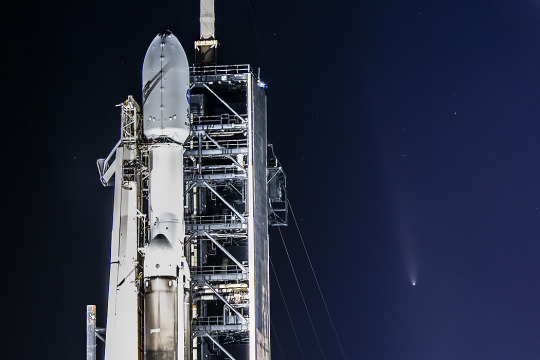
2024 October 17
The Clipper and the Comet Image Credit & Copyright: Ben Cooper (Launch Photography)
Explanation: NASA's Europa Clipper is now headed toward an ocean world beyond Earth. The large spacecraft is tucked into the payload fairing atop the Falcon Heavy rocket in this photo, taken at Kennedy Space Center the day before the mission's successful October 14 launch. Europa Clipper's interplanetary voyage will first take it to Mars, then back to Earth, and then on to Jupiter on gravity assist trajectories that will allow it to enter orbit around Jupiter in April 2030. Once orbiting Jupiter, the spacecraft will fly past Europa 49 times, exploring a Jovian moon with a global subsurface ocean that may have conditions to support life. Posing in the background next to the floodlit rocket is Comet Tsuchinsan-ATLAS, about a day after the comet's closest approach to Earth. A current darling of evening skies, the naked-eye comet is a vistor from the distant Oort cloud
∞ Source: apod.nasa.gov/apod/ap241017.html
119 notes
·
View notes
Text
you don't want to be able to stare at the black abyss all day
we've seen what it does when there's stars, for those stuck on the surface, space-side. I don't want to know what it's like when there's nothing but murky waters and possible Lovecraftian horrors. I'm not picking up the pieces of vets who go through that shit, no way.
There's no windows on a sub. They started adding 'em to subs back on cradle once they figured out the first metallo glass alloys. Helps stop the crew from going too crazy.
Not on Europa. Not even the new stuff is rated for the depths you need to hit to dodge by sub-crust sonar installations. Not that it would matter, no light gets past even the first click of opaque surface ice, let alone ten.
You undock, drop through the bay tunnel, dodge a couple of skyscraper sized spires of brine ice sticking down from above, and then nothing. Pings don't find anything bigger than sediment for weeks, and you know it's darker out there than it is on the surface.
Sometimes you gotta do a walk, hop out to check external equipment, so you slip into the clamshell and hope the last guy didn't sweat too hard. Then you sit through inspection. Rooks always complain about inspection, but when your CO points out you didn't bother to tether for the first time you shape up.
Yeah the clams have maneuvering, you could get up to about half fhe speed of the sub at full if you had to, but thats not what the tethers for.
You step out that hatch for the first time and you see the little bits of crud floating in the black, lit by torch like stars? That's magic.
You step over to the side, look down, and see the black that goes forever? Well, that's when you feel the jolt, hear the rattle of the tether going tight at your back and Ops shouting into your headset. Dangling maybe 20 meters under the hull, nothing between you and eternity.
Heard someone say that if you dropped for real you'd sink for a month at least before you hit anything solid, if theres anything solid at all.
I believe them.
And look, I know that after all that you're nodding your head and shootin' a look at your friend accross the table. The SO sardines have the crazies, always so sad to hear it you know? But believe me when I say that when you're falling asleep you can hear them, tapping on the outside of the hull, right by your head.
There's something out there, and if I'm really lucky I finish my tour before we find out what.
-blackbox retrieval, author unknown.
#ice war#europa ice war#war forever#europa#subsurface#subsurface ocean#ocean#submarine#horrors in the deep#abyss#thalassophobia#lovecraftian horror#own text#text
433 notes
·
View notes